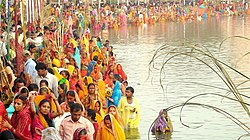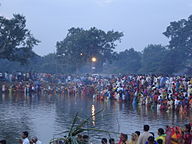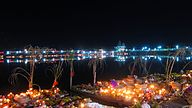Chhath Puja
Chhath
past your adsense code
From Wikipedia, the free encyclopedia
(Redirected from Chath puja)
| Chhath Puja छठ पूजा | |
|---|---|

Performing of evening & morning Pray to Sun around the holy River/pond
| |
| Official name | Chhath Puja |
| Also called | Chhathi Chhath Parv Chhath Puja Dala Chhath Dala Puja Surya Shashthi |
| Observed by | |
| Liturgical Color | Colors related to Hinduism Saffron (or Bhagwa) |
| Type | Cultural, Historical, Religious |
| Significance | To thank Sun for bestowing the bounties of life on earth and fulfilling particular wishes |
| 2015 date | November 15 to November 18[1] |
| 2016 date | November 4 to November 7[2] |
| Part of a series on |
| Hinduism |
|---|
 |
Chhath (Devanagari: छठ, छैठ, छठी, छठ पर्व, छठ पुजा, डाला
छठ, डाला पुजा, सूर्य षष्ठी) is an ancient Hindu Vedic festival historically native to eastern Uttar Pradesh, North Bihar of India and Mithila State of Nepal.[3][4][5][6] The Chhath Puja is dedicated to the Sun and his wifeUsha in order to thank them for bestowing the bounties of life on earth and to request the granting of certain wishes. This festival is observed by Nepalese people and Indian people, along with their diaspora.[7]
छठ, डाला पुजा, सूर्य षष्ठी) is an ancient Hindu Vedic festival historically native to eastern Uttar Pradesh, North Bihar of India and Mithila State of Nepal.[3][4][5][6] The Chhath Puja is dedicated to the Sun and his wifeUsha in order to thank them for bestowing the bounties of life on earth and to request the granting of certain wishes. This festival is observed by Nepalese people and Indian people, along with their diaspora.[7]
The Sun, considered as the god of energy and of the life-force, is worshiped during the Chhath festival to promote well-being, prosperity and progress. In Hinduism, Sun worship is believed to help cure a variety of diseases, including leprosy, and helps ensure the longevity and prosperity of family members, friends, and elders.
The rituals of the festival are rigorous and are observed over a period of four days.[8] They include holy bathing, fasting and abstaining from drinking water (Barta), standing in water for long periods of time, and offering prashad (prayer offerings) and arghyato the setting and rising sun. Some devotees also perform a prostration march as they head for the river banks.[9]
Environmentalists claim that Chhath is the most eco-friendly Hindu festival.[10] Although the festival is observed most elaborately inMithila Province of Nepal,Terai-Madhesh region of Nepal, Indian states of Bihar, Jharkhand and UP, it is also more prevalent in areas where migrants from those areas have a presence. It is celebrated in all Northern regions and major Northern urban centers in India bordering Nepal. The festival is celebrated in the regions including but not exclusive to the northeast region of India, Madhya Pradesh, Uttar Pradesh, Chhattisgarh, Chandigarh, Gujarat[11][12] Bangalore,[13] Mauritius, Fiji, South Africa, Trinidad and Tobago,Guyana, Suriname, Jamaica, other parts of the Caribbean, United States, United Kingdom, Republic of Ireland, Australia, New Zealand, Malaysia, Macau, Japan, and Indonesia.
Date of the festival[edit]
Chhath puja is performed on Kartika Shukla Shashthi, which is the sixth day of the month of Kartika in the Vikram Samvat. This falls typically in the month of October or November in the Gregorian English Calendar. The exact date of the festival is decided by Central division of Janakpurdham in Mithila Region of Nepal which is applicable to worldwide adherents.
It is also celebrated in the summer (March–April), on Chaitra Shashthi, some days after Holi; this event is called Chaiti Chhath.[14] The former is more popular because winter is the usual festive season in Nepal and also in Bihar of North India. Chhath is an arduous observance, requiring the worshipers to fast without water for around 36 hours continuously.
Etymology[edit]
The word chhath means sixth in Nepali, Maithili and Bhojpuri languages and the festival is celebrated on the sixth day of the monthKārtika of the Hindu lunar Bikram Sambat calendar. The word is a Prakrit derivation from the Sanskrit ṣaṣṭhi, meaning sixth.It is the longest and most important festival after navratri. The very first day of chhath starts exactly 4 days from Diwali and last for 4 more days. This day the people who observe fast take bath at a river or pond and prepare lunch (consisting of rice,dal mixed with pumpkin and pumpkin, made in pure ghee). The second day (5th day from Diwali) is known as kharna or kheer- roti. In which the kheer( A Indian recipe where rice is prepared with sweetened milk instead of water) and chapati ( called roti in many Indian provinces). The people observe fast for the full day without taking even water and eat this kheer-roti as dinner after offering it to the rising moon and Goddess Ganga. This is the only time when they eat or drink anything from the starting of the day till the last day of chhath. The third day is the main festival day (exactly 6th day from Diwali) of chhath. The devotees maintain 'nirjal vrat' ( Fast without even taking a drop of water ) on the third day. It mainly consist of going on river bank and offering 'argha' ( offering of fruits and sweets in winnow ) and surya namaskar to the setting sun followed by the next day (exactly 7th day from Diwali) event of offering argha and surya namaskar to the rising sun on the fourth or last day of chhath. The fast is then come to end after offering argha to rising sun. In this way, nearly 42 hours of strict penance comes to an end.
History[edit]
It is believed that the ritual of Chhath puja may even predate the ancient Vedas texts, as the Rigveda contains hymns worshiping the Sun god and describes similar rituals. The rituals also find reference in the Sanskrit epic poem Mahābhārata in which Draupadi is depicted as observing similar rites.
In the poem, Draupadi and the Pandavas, rulers of Indraprastha (modern Delhi), performed the Chhath ritual on the advice of noble sage Dhaumya. Through her worship of the Sun God, Draupadi was not only able to solve her immediate problems, but also helped the Pandavas later regain their lost kingdom.
Its yogic/scientific history dates back to the Vedic times. The rishis of yore used this method to remain without any external intake of food as they were able to obtain energy directly from the sun's rays. This was done through the Chhath method.[15]
Another history behind celebrating the Chhath puja is the story of Lord Rama. It is considered that Lord Rama of India and Sita of mithila had kept fast and offer puja to the Lord Sun in the month of Kartika in Shukla Paksh during their coronation after returning to the Ayodhya after 14 years of exile. From that time, chhath puja became the significant and traditional festival in the Hindu religion and started celebrating every year at the same date in Sita's homeland janakpur and adjoining Indian states of Bihar,
Chhathi Maiya[edit]
The Goddess who is worshipped during the famous Chhath Puja is known as Chhathi Maiya. Chhathi Maiya is known as Usha in the Vedas. She is believed to be the beloved younger wife of Surya, the sun god. This is the only parva which signifies rising sun as well as setting sun both (छठ पूजा एक ऐसा श्रेष्ठतम पर्व हैं जहाँ डूबते हुए सूर्य से प्रार्थना करते हुए व्रत का प्रारंभ होता है एवं सूर्योदय कि पूजा के पश्चात व्रत सम्पूर्ण होता हैं "जैसे कि जीवन के संचालन के लिए रात्रि का उतना ही महत्व है जितना दिन का")
Rituals and traditions[edit]
Chhath is a festival of bathing and worshipping,that follows a period of abstinence and segregation of the worshiper from the main household for four days. During this period, the worshiper observes purity, and sleeps on the floor on a single blanket.This is the only holy festival which has no involvement of any pandit (priest).The devotees offer their prayers to the setting sun, and then the rising sun in celebrating its glory as the cycle of birth starts with death. It is seen as the most glorious form of Sun worship.
Nahay khay/Arwa Arwain[edit]
On the first day of Chhath Puja, the devotees take a dip, preferably in the river Kosi river, Karnali and Ganga and carry home the holy water of these historical rivers to prepare the offerings. The house and surroundings are scrupulously cleaned. The ladies observing the Vrata called vratin allow themselves only one meal on this day.
Lohanda and Kharna(Argasan)[edit]
On the second day of Chhath Puja, the day before Chhath, the Vratins observe a fast for the whole day, which ends in the evening a little after sunset. Just after the worship of Sun and moon, the offerings of Kheer (rice delicacy), chappatis (of wheat flour) and bananas, are distributed among family and friends. The Vratins go on a fast without water for 36 hours after 2nd day evening prashad (kheer)..
Sandhya Arghya (evening offerings) OR Pahela Aragh[edit]
This day is spent preparing the prasad (offerings)at home. On the eve of this day, the entire household accompanies the Vratins to a riverbank, pond or a common large water body to make the offerings (Arghya) to the setting sun. It is during this phase of Chhath Puja that the devotees offer prayers to the just setting sun. The occasion is almost a carnival. Besides the Vratins, there are friends and family, and numerous participants and onlookers, all willing to help and receive the blessings of the worshipper. The folk songs sung on the evening of Chhath.
Usha Arghya (morning offerings) OR Dusra Aragh[edit]
On the final day of Chhath Puja, the devotees, along with family and friends, go to the riverbank before sunrise, in order to make the offerings (Arghya) to the rising sun. The festival ends with the breaking of the fast by the Vratins. Friends, Relatives visit the houses of the devotees to receive the prashad.
The main worshipers, called Parvaitin (from Sanskrt parv, meaning 'occasion' or 'festival'), are usually women. However, a large number of men also observe this festival. The parvaitin pray for the well-being of their family, and for the prosperity of their offsprings. Once a family starts performing Chhatt Puja, it is their duty to perform it every year and to pass it on to the following generations. The festival is skipped only if there happens to be a death in the family that year.
The prasad offerings include sweets, Kheer, Thekua, laddu made of rice grit and fruit (mainly sugarcane, sweet lime and banana) offered in small bamboo soop winnows. The food is strictly vegetarian and is cooked without salt, onions or garlic. Emphasis is put on maintaining the purity of the food.[16]
Regional differences of rituals and traditions[edit]
There are few differences in rituals and traditions which have been observed between devotees performing Chhath Puja in Northern parts of Bihar and those of South Bihar. The north and south Bihar are divided by the river Ganges and so is the distinction between regions. Some traditions of the Puja are quite strict in North Bihar whereas it is more liberal in South Bihar. In general, it is the tradition that Thekua which is the Prasad (Offering to the God) should be strictly prepared on "mitti chulha" (traditional earthen stove) by using clean "wood sticks" as the fuel. This is religiously followed in most of the places except urban areas where firewood is unavailable.
Gallery[edit]
- Chhath Puja








Comments
Post a Comment